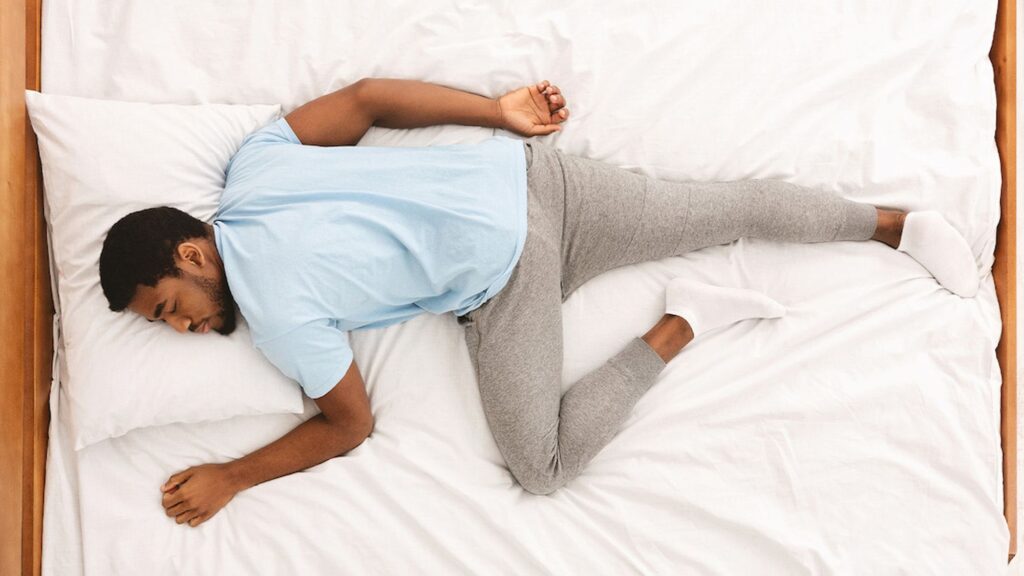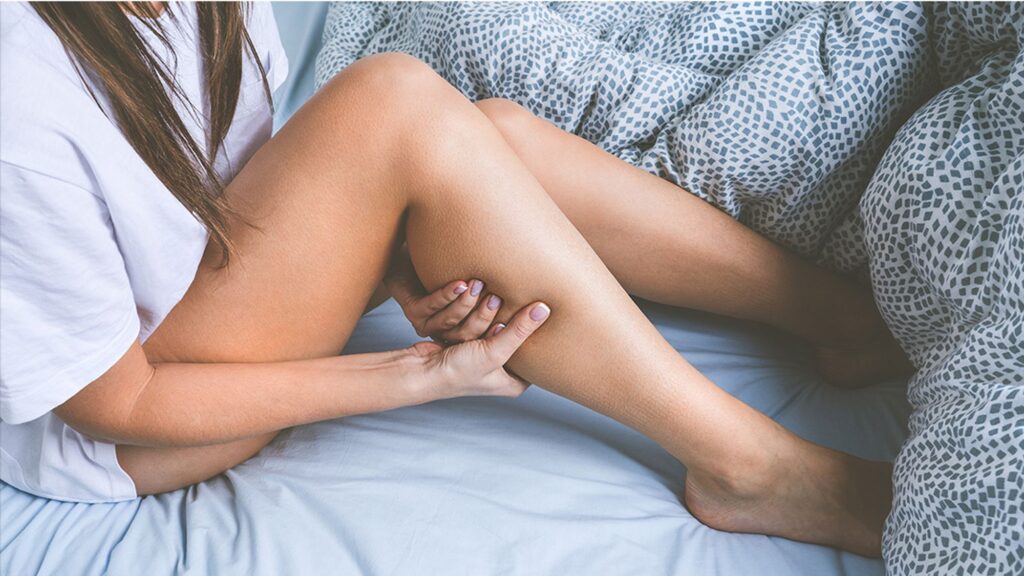
Periodic limb movement disorder (PLMD) is a condition marked by repetitive uncontrollable jerks or twitches in regular and frequent intervals. Because it typically occurs while the person is sleeping, it’s usually a bed partner who bears the brunt of the disorder. While mild cases of PLMD may be benign, moderate to severe cases can lead to daytime sleepiness, cognitive impairments, and, if you’re not careful, maybe even a sleep divorce.
Long Story Short
- Periodic limb movement disorder is a sleep disorder characterized by twitching, jerking, and kicking of the legs.
- While symptoms and partner testimonials are helpful, a sleep study is required to diagnose periodic limb movement disorder.
- There is no cure for PLMD, but pharmacological interventions and lifestyle changes may help control symptoms.
What Is Periodic Limb Movement Disorder?
Stewart Parnacott, a certified registered nurse anesthetist and instructor at Baylor College of Medicine, tells Sleepopolis that periodic limb movement disorder ”is a “neurological sleep disorder characterized by repetitive and involuntary movements of the legs and, in some cases, the arms during sleep. These movements are referred to as periodic limb movements (PLMs), which occur at regular intervals, typically every 20 to 40 seconds.” (1)
Carleara Weiss, Ph.D., MSH, RN and Sleep Science Advisor for Aeroflow Sleep, adds, “Most of these repetitive movements occur in the lower extremities, including the toes, ankles, knees, and hips, and occasionally in the upper extremities. A person may or may not wake up when experiencing PLMD. For those who wake up, excessive daytime sleepiness becomes a prominent symptom.” (2)
Also referred to as sleep-related myoclonus syndrome or nocturnal myoclonus syndrome, the movements associated with PLMD are twitching, jerking, or flexing of the limbs. (2) These movements typically occur during periods of light sleep or non-REM sleep. Limb movements and their frequency varies from night to night and person to person.
What Is the Difference Between Periodic Limb Movement Disorder (PLMD) And Periodic Limb Movements of Sleep (PLMS)?

While the two terms may seem similar, Parnacott says, “It’s essential to distinguish PLMD from Periodic Limb Movements of Sleep (PLMS). PLMD encompasses not only sleep-related movements but also the daytime symptoms associated with this disorder. PLMS, on the other hand, refers specifically to limb movements during sleep.”
Weiss adds that confusion stems from the fact that “both conditions indicate limb movement during sleep. However, she notes, “PLMD is considered rare and is an individual condition. Meanwhile, PLMS is more common and may be associated with Restless Leg Syndrome, REM Sleep Behavior Disorder (RBD), or Narcolepsy.”
Periodic Limb Movement Disorder vs. Restless Leg Syndrome
In addition to being confused with PLMS, periodic limb movement disorder is also frequently confused with Restless Leg Syndrome (RLS). And while the two are again similar, they are some important differences. RLS is marked by unpleasant sensations or tingling in the legs, accompanied by an irresistible urge to move them (which incidentally also brings some measure of relief). (3) Pain or discomfort are not typical symptoms of PLMD.
The primary difference between the two disorders lies in timing. Whereas PLMD only occurs during sleep, RLS symptoms typically occur during rest periods and can happen while the person is awake or asleep.
How Common Is PLMD?
It’s currently estimated that PLMD occurs in 4–11 percent of the adult population and 5–8 percent of the pediatric population. (1) While it appears that PLMD is evenly distributed between men and women, the prevalence of periodic limb movement disorder increases with age. According to The American Academy of Sleep Medicine, up to 34 percent of people over 60 grapple with PLMD. (4)
Primary PMLD vs. Secondary PLMD
PLMD can be classified as primary PLMD or secondary PLMD. While researchers have yet to pinpoint the cause of primary PLMD, secondary PLMD is usually the result of an underlying health condition. The symptoms in each case remain the same.
What are the Causes and Symptoms of Periodic Limb Movement Disorder?
Causes
“The causes of PLMD are diverse and can be related to various factors,” says Parnacott. “Some common underlying conditions include iron deficiency, kidney disease, peripheral neuropathy, and spinal cord lesions. (2) Additionally, certain medications (like dopamine blockers and SSRIs or anti-depressants) and other sleep disorders like restless leg syndrome (RLS) may contribute to the development of PLMD.” (2)
Research has also shown that PLMD is common among those with sleep apnea. (5) Interestingly, studies have shown that PLMD may be caused by mild obstructive sleep apnea, and CPAP treatment improved symptoms. On the other hand, researchers have found that CPAP may cause PLMD. (2)
Other risk factors include
- Age
- Restless leg syndrome
- Sedentary lifestyles
- Smoking
- Caffeine consumption
- Obesity
- Diabetes
- Anti-depressant use
- Magnesium deficiency
- Gene expression
Symptoms
The primary symptom associated with PLMD is twitches and jerks that occur every 20 to 40 seconds during sleep. (1) Those with PLMD don’t report any pain or discomfort themselves, but bed partners may feel some discomfort from being kicked repeatedly throughout the night!
Impacts Of Periodic Limb Movement Disorder
With limb movements that occur in regular 20 to 40-second intervals, periodic limb movement disorder can understandably take a toll on your sleep quality. If left untreated, it may begin to affect your physical and mental health.
Impacts On Sleep
“PLMD can significantly impact sleep quality and disrupt sleep architecture,” says Parnacott. “Frequent limb movements can lead to frequent awakenings, preventing individuals from achieving restorative deep sleep. (2) Consequently, those affected may experience daytime fatigue, excessive daytime sleepiness, and impaired cognitive function.”
Other sleep issues commonly associated with PLMD include:
- Insomnia
- Delayed sleep onset
Impacts On Mental and Physical Health
“The impact of PLMD extends beyond sleep disturbances.” says Parncott. “The disrupted sleep patterns and chronic sleep deprivation caused by PLMD can have adverse effects on mental health, leading to mood disorders like depression and anxiety. Furthermore, repeated muscle contractions during sleep can cause physical discomfort and muscle soreness, affecting overall physical well-being.”
Research has also shown that hypertension may be a factor for those with PLMD — most likely, this is a direct result of an imbalance between the sympathetic nervous system and the parasympathetic nervous system. Ultimately, PLMD can be a real risk factor for stroke, hypertension, and heart disease. (2)
Can PLMD Be Prevented?
Without knowing what causes primary PLMD, it’s hard to say whether the condition can be prevented or not. Regarding secondary PLMD, however, its links to other medical conditions indicate that it may be possible to prevent the sleep disorder by managing or resolving those conditions.
How is Periodic Limb Movement Disorder Diagnosed?
Like many sleep disorders, the road to diagnosis for PLMD often begins with a sleep history asessment, physical exam, and details from a bed partner. However, the aforementioned tools can only give doctors a part of the picture. For that reason, a polysomnogram (sleep study) is the best diagnostic tool for PLMD as it can clearly detect movements during sleep. (2)
We should also note that PLMD is typically a diagnosis of exclusion. (2) So a polysomnogram is necessary to rule out other sleep conditions that may account for the movements during sleep, like sleep apnea, for example.
According to the latest edition of The International Classification of Sleep Disorders, those with suspected PLMD must meet specific criteria for a PLMD diagnosis. More specifically, adults must experience more than 15 periodic limb movements per hour, while children must experience more than five per hour. (2)
Treatments for Periodic Limb Movement Disorder
“In addressing PLMD, a variety of treatment options are available to help individuals manage the disorder effectively, the primary goal of which is to alleviate limb movements during sleep and improve sleep quality,” says Parnacott. Regarding pharmacological interventions, Parnacott says, “Medications such as dopaminergic agents, benzodiazepines, and anticonvulsants may be prescribed based on individual needs and medical history.” (2)
Beyond medications, he adds, “Lifestyle changes, including regular exercise, stress reduction, and improving sleep hygiene, can also contribute to symptom management.”
When To See a Doctor
If PLMD doesn’t affect your sleep or your daily life, treatment may not be necessary. If daytime sleepiness and fatigue become normal or your bed partner frequently complains about being on the receiving end of your kicks, it may be time to take your (and their) concerns to your doctor.
The Last Word From Sleepopolis
Periodic limb movement disorder, or PLMD, is a sleep disorder characterized by episodes of repetitive limb movements during sleep. Most of these movements occur in the lower extremities, including the toes, ankles, knees, and hips, in 20 to 40-second intervals. Mild cases of PLMD may not require medical intervention, but poor sleep quality, excessive daytime sleepiness, and a grumpy partner are clear signs that it may be time to see your doctor.
FAQS
Does PLMD keep you awake at night?
PLMD occurs during sleep. And while it doesn’t keep you awake at night per se, it can lead to frequent wakings, fragmented sleep, and insomnia.
Sources
- Drakatos P, Olaithe M, Verma D, et al. Periodic limb movements during sleep: a narrative review. J Thorac Dis. 2021;13(11):6476-6494. doi:10.21037/jtd-21-1353
- Joseph V, Nagalli S. Periodic Limb Movement Disorder. [Updated 2024 Feb 14]. In: StatPearls [Internet]. Treasure Island (FL): StatPearls Publishing; 2024 Jan-. Available from: https://www.ncbi.nlm.nih.gov/books/NBK560727/
- U.S. Department of Health and Human Services. (n.d.). Restless legs syndrome. National Institute of Neurological Disorders and Stroke. https://www.ninds.nih.gov/health-information/disorders/restless-legs-syndrome
- Periodic Limb Movements. Sleep Education. (2021, May 6). https://sleepeducation.org/sleep-disorders/periodic-limb-movements/
- Manconi M, Zavalko I, Bassetti CL, Colamartino E, Pons M, Ferri R. Respiratory-related leg movements and their relationship with periodic leg movements during sleep. Sleep. 2014;37(3):497-504. Published 2014 Mar 1. doi:10.5665/sleep.3484
- Carleara Weiss, Ph.D., MSH, RN. Email Communication. July 31, 2024.
- Stewart Parnacott. Email Communication. July 31, 2024.


























